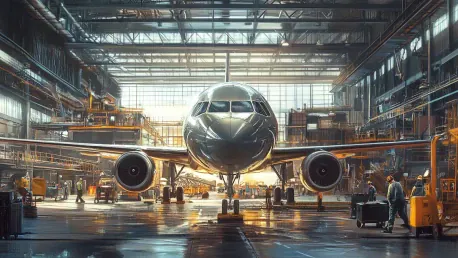The subject of analysis revolves around the potential consequences of newly imposed tariffs by the U.S. administration under President Donald Trump, specifically on the aircraft manufacturing industry. These tariffs include a 25% tariff on imports from Mexico and Canada and a 10% tariff on goods from China. The focus is on understanding the implications of these heightened costs on the intricate global supply chain crucial to aircraft manufacturing, including the components most significantly affected and the strategic adjustments required by industry stakeholders.
The Global Supply Chain in Aircraft Manufacturing
The U.S. Government Accountability Office (GAO) identified a complex, interconnected network of global suppliers essential to aviation manufacturing. According to a 2024 congressional report reviewed by Phillip Gulley from Cofactr, the U.S. aviation manufacturing supply chain heavily depends on materials sourced from international suppliers, predominantly from France, Canada, Japan, Germany, and the United Kingdom. A notable example is Boeing’s 737, which utilizes approximately 700 suppliers to assemble its two million parts. This highlights the immense reliance on international trade for raw materials and components, critical for meeting production demands.
Gulley notes that the announcement of tariffs has caused a ripple of uncertainty across the industry, leading to anxiety or a “holding one’s breath” scenario amongst entities involved. Defense contractors have proactively tried to diversify their supply chains away from China. However, expanding tariffs to include key partners like Canada and Mexico might push these firms into a significantly expensive modification requiring decades-old logistical relationships to transform.
Impact on Essential Components and Cost Structures
A primary concern involves how added tariffs might affect the procurement and cost structures of essential components such as engines, semiconductors, and raw materials. Given that airplanes consist of numerous electronics—almost 20-30% of their total cost—the application of a 10% tariff on Chinese imports, which form a key chunk of these components, is a significant financial burden. According to Gulley, one-third of the materials sourced by manufacturers from China directly influences nearly 10% of the aircraft’s value, leading to potential price hikes across the supply chain tiers.
Another critical aspect is the potential shift in subassembly manufacturing, particularly components like Rolls-Royce engines produced in Canada, which might become costlier due to the new tariffs. Furthermore, ice protection systems, landing gear systems, and environmental controls, essential to both Airbus and Boeing, entail substantial manufacturing input from countries such as China and Mexico. This further complicates the production process, adding layers of complexity to an already intricate network of suppliers and assembly lines.
Strategic Adjustments and Industry Response
Gulley emphasizes that the supply chain’s response remains uncertain as the industry awaits clearer directives. This ambiguity is elevated by concerns over potential retaliatory tariffs from affected countries, which could introduce additional complications and price fluctuations. Aircraft manufacturers might be compelled to re-evaluate and possibly localize parts of their production, leading to increased costs and logistical challenges, a process fraught with uncertainties and financial risks.
The overarching theme is that new tariffs will inevitably escalate the cost of manufacturing in nearshore environments. This cost surge threatens the existing equilibrium within aerospace supply chains, founded on decades of strategic relationships and efficient, cross-border material movement. Given the intertwined nature of global supply chains, the repercussions of such tariffs may be profound, affecting operations and financial outlays across the board, leading to perhaps unforeseen adjustments within the industry.
Navigating Uncertainty and Future Trade Policies
The analysis centers on the potential consequences of newly introduced tariffs by the U.S. administration under President Donald Trump, particularly targeting the aircraft manufacturing sector. These tariffs consist of a 25% levy on imports from Mexico and Canada, and a 10% duty on goods from China. The focus is on understanding how these increased costs could impact the complex global supply chain essential for aircraft manufacturing. This includes identifying which components are most adversely affected and determining the necessary strategic adjustments industry stakeholders must implement. Industry players may need to explore alternative sourcing options and adjust financial strategies to mitigate the impact. The outcome could lead to increased production costs, potential delays, and a need for renegotiation of existing contracts. Furthermore, the broader economic implications, such as potential retaliatory tariffs and market shifts, necessitate careful consideration by those in the aircraft manufacturing industry. The tariffs could reshape the competitive landscape, necessitating agility and adaptation.









